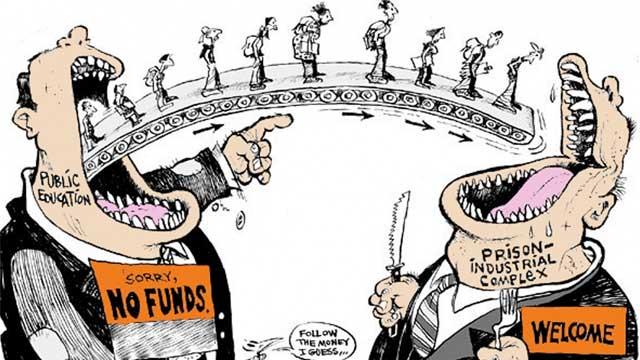
By now the phrase “school-to-prison pipeline” is at least recognizable to the Left. Its presence in our political lexicon serves as a reminder that our public schools and, increasingly, our diffuse prison apparatus are at times operationally and institutionally indistinct, a fact not lost on those who negotiate both.
The school-to-prison pipeline is an interlocking system of local, state, and federal educarceral policies that unduly, and often imperceptibly, siphon students from the school yard to the prison yard. The “pipeline” disproportionately criminalizes youth of color through zero-tolerance disciplinary policies such as suspension or expulsion, as well as ineffective retention programs, academic isolation, and culturally irrelevant pedagogy and curricula.
Criminalizing minor infractions in conjunction with the intrusion of law enforcement officials in spaces of learning serves two mutually reinforcing ends. First, it reduces students to suspects, and second, it naturalizes the specious linkage between youth of color and criminality. The Washington Post recently reported that “when it comes to being arrested in school, students of color are once again at disproportionately higher risk.” According to data released last March by the U.S Department of Education, 96,000 students were arrested and 242,000 were referred to law enforcement by schools from 2009-2010. Black and Latino students accounted for more than 70 percent of arrested or referred students.
Though the school-to-prison pipeline further marginalizes the most oppressed among us, it’s folly to assume that the pipeline is unidirectional. Though architects and analysts of education policy have spilled much ink scrutinizing the origins, movement, and consequences of the school-to-prison pipeline, paltry attention has been paid to its inverse: the prison-to-school pipeline. By and large, texts investigating the operations of the prison-to-school pipeline are nowhere to be found. In fact, Google’s Ngram Viewer—a tool that tracks the popularity of words and phrases in past and present books and articles—didn’t return a single match to the phrase “prison-to-school pipeline.”
In many ways, the school-to-prison pipeline relies on the seemingly invisible operations of its companion—the prion-to-school pipeline— for its very survival. The practice of reducing students to suspects worthy of surveillance through the liberal use of correctional officers in schools—and the norms, codes, and assumptions they inevitably import to spaces of learning—is the most lurid expression of the prison-to-school pipeline.
Earlier this month news media reported that one school district in Arizona recently called upon correctional officers from Corrections Corporation of America (CCA)—the nation’s largest and oldest publicly-traded, for-profit private corrections firm—to conduct a scheduled “drug sweep.”
According to the Casa Grande Dispatch—a regional newspaper serving Southern Arizona—on the morning of October 31st “eight officers with dogs from Casa Grande Police, Gila River Police, Arizona Department of Public Safety and Corrections Corporation of America arrived at [Vista Grande High School] at 9 a.m. and the school was placed on lock-down. Every vehicle, backpack and classroom was searched by the dogs…Three students were arrested on possession of marijuana and of drug paraphernalia charges [after] a scheduled drug sweep at [the school.] The drug search was done at the request of the school district.”
Dr. Shannon Goodsell, Superintendent of Casa Grande Union High School District, authorized the “sweep.” The correctional officers from CCA involved in the “bust” are presumably employed at one of the company’s three facilities in Eloy, a town located just twenty miles southeast of Casa Grande. Perhaps CCA’s presence at Vista Grande High School —perverse “recruiting” tactic, really—reflects the company’s anxiety over losing nearly 2,000 inmates from its Red Rock facility in Eloy once its contract with the State of California expires in 2014.
Precisely why Superintendent Goodsell sanctioned a for-profit, private correctional incursion into a public high school, particularly a public high school in which students of color are overrepresented, generates a number of questions. I placed numerous calls to Superintendent Goodsell’s office inquiring about CCA’s involvement in the Vista Grande incident, but at the time of publication, my calls had all gone unanswered.
Whatever the outcome of these events, one thing is for certain: CCA’s presence as a disciplinary force in our public schools is deeply disturbing. Commingling CCA’s legal obligation to increase shareholder value through criminalization with the mission of public schools—the promotion of a free and open society—will invariably enrich the former precisely by perverting the latter.
3 WAYS TO SHOW YOUR SUPPORT
- Log in to post comments













